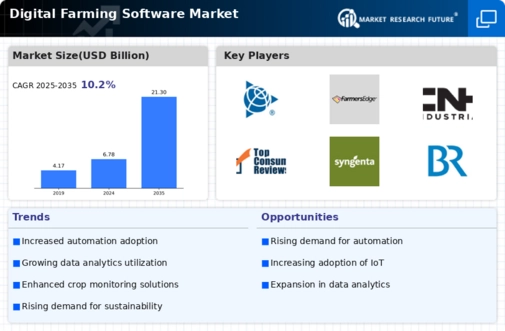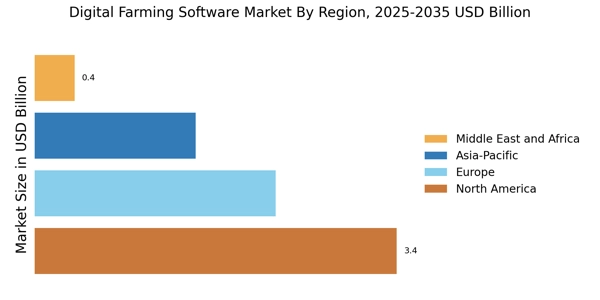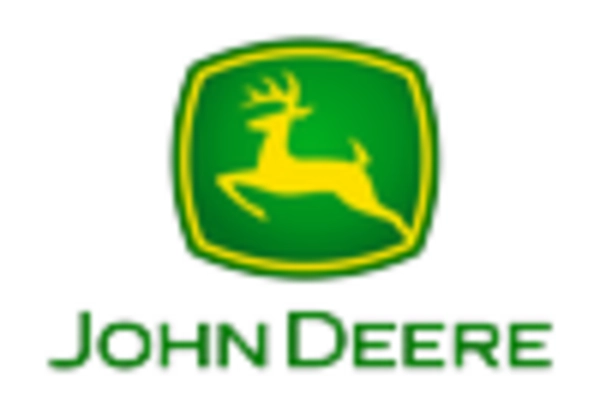Increased Adoption of Precision Agriculture
The Digital Farming Software Market is experiencing a notable surge in the adoption of precision agriculture techniques. Farmers are increasingly utilizing software solutions that leverage data analytics, satellite imagery, and IoT devices to optimize crop yields and resource management. According to recent estimates, the precision agriculture market is projected to reach USD 12 billion by 2025, indicating a robust growth trajectory. This trend is driven by the need for enhanced efficiency and productivity in farming practices, as well as the growing awareness of sustainable agricultural methods. As farmers seek to maximize their output while minimizing environmental impact, the demand for digital farming software that supports precision agriculture is likely to continue its upward trend.
Rising Demand for Sustainable Farming Practices
The Digital Farming Software Market is increasingly influenced by the rising demand for sustainable farming practices. Consumers are becoming more conscious of the environmental impact of agriculture, prompting farmers to adopt practices that reduce carbon footprints and promote biodiversity. Digital farming software plays a crucial role in this transition by providing tools for monitoring soil health, managing water resources, and optimizing fertilizer use. Reports suggest that the sustainable agriculture market is expected to grow at a CAGR of 10% through 2025, reflecting a shift towards eco-friendly farming solutions. As sustainability becomes a priority for both consumers and producers, the demand for digital farming software that facilitates these practices is anticipated to rise significantly.
Advancements in Data Analytics and Machine Learning
The Digital Farming Software Market is witnessing transformative advancements in data analytics and machine learning technologies. These innovations enable farmers to analyze vast amounts of data collected from various sources, including weather patterns, soil conditions, and crop health. By harnessing these insights, farmers can make informed decisions that enhance productivity and reduce costs. The integration of machine learning algorithms into digital farming software allows for predictive analytics, which can forecast crop yields and identify potential issues before they arise. As the agricultural sector increasingly relies on data-driven strategies, the demand for sophisticated digital farming software equipped with advanced analytics capabilities is expected to grow, potentially reshaping the industry landscape.
Growing Investment in Agricultural Technology Startups
The Digital Farming Software Market is experiencing a surge in investment directed towards agricultural technology startups. Venture capitalists and investors are increasingly recognizing the potential of digital solutions to revolutionize farming practices. This influx of capital is facilitating the development of innovative software solutions that address various challenges faced by farmers, from crop management to supply chain optimization. Reports indicate that investment in agtech startups reached USD 4 billion in 2025, underscoring the growing interest in this sector. As these startups continue to innovate and bring new technologies to market, the demand for digital farming software is likely to increase, further driving the evolution of the industry.
Government Initiatives and Support for Digital Agriculture
The Digital Farming Software Market is significantly bolstered by government initiatives aimed at promoting digital agriculture. Various governments are recognizing the potential of technology in enhancing agricultural productivity and sustainability. Initiatives such as subsidies for technology adoption, funding for research and development, and training programs for farmers are becoming more prevalent. For instance, several countries have launched programs to support the integration of digital tools in farming practices, which is likely to drive the adoption of digital farming software. As these initiatives gain momentum, the market for digital farming solutions is expected to expand, providing farmers with the necessary resources to modernize their operations.


















Leave a Comment